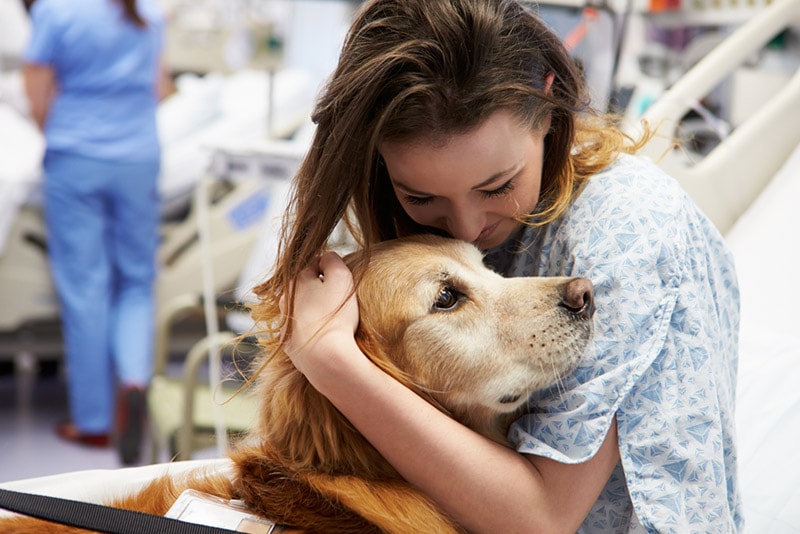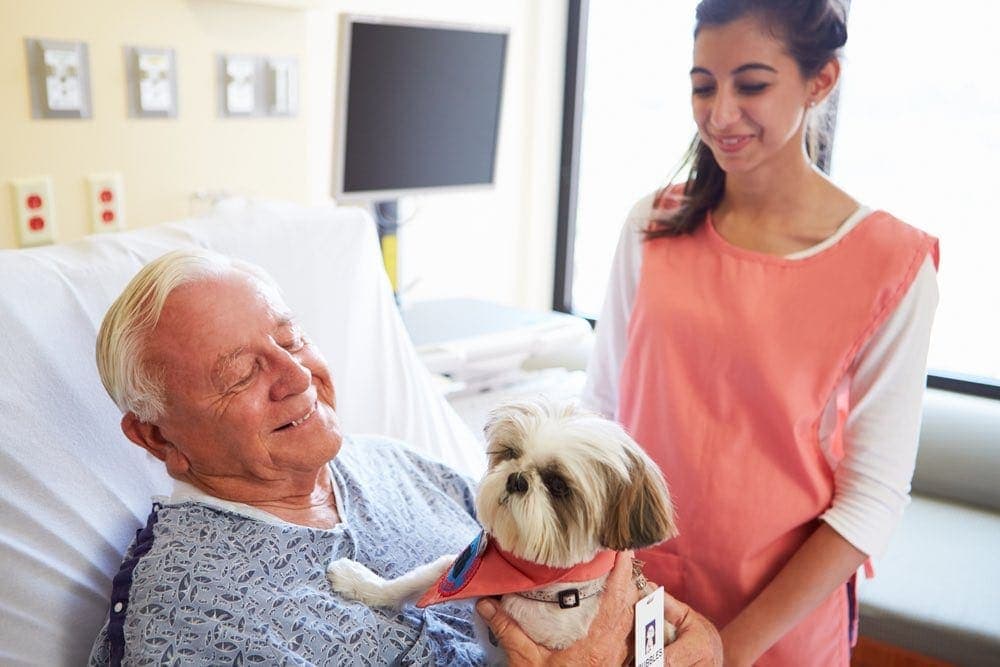What Do Therapy Dogs Do? General Tasks, Facts & FAQ

Updated on

Therapy dogs are a special type of dog that provides comfort and support to people in hospitals, nursing homes, schools, disaster areas, and other settings. Many therapy dogs are trained by their owners or professional trainers.
Because therapy dogs can be relied on to behave well even in high-pressure or stressful situations, they are an important part of many organizations that care for people in need. For example, some hospitals and nursing homes use therapy dogs to help patients relax and reduce pain.
Moreover, therapy dogs can be any size or breed if they have the right temperament and training. Read on to learn what this means and more.
How Therapy Dogs Help
There are many ways that therapy dogs can help people in need. Some of the most common examples include:
- Lowering stress and anxiety levels, particularly in those who are hospitalized or recovering from an injury or illness
- Providing comfort and companionship to children who may be lonely or struggling in school
- Boosting the morale of disaster relief workers, such as after a traumatic event
- Helping individuals with disabilities lead more independent lives by providing assistance and support when needed
Overall, therapy dogs play an important role in helping people feel happier and more relaxed in a variety of situations. While anxiety is a widespread issue for everyone, children are especially at risk.
According to Psychology Today, anxiety in children is the highest it’s ever been. Some of the most common symptoms of anxiety in children include excessive worrying, difficulty concentrating or focusing, sleep problems, irritability, and physical symptoms like nausea.
And one way that therapy dogs can help mitigate these symptoms is by providing comfort and a sense of security to anxious children. This can be especially helpful in situations where children are struggling with fear or trauma, such as after a natural disaster or act of violence.

What Tasks Does a Therapy Dog Do?
In addition to helping children cope with anxiety and other mental health issues, therapy dogs can also support individuals with disabilities or chronic medical conditions.
For example, service dogs can be trained to help people manage their symptoms or perform certain tasks like retrieving medication bottles at the appropriate time or even alerting others if the person has a medical emergency.
There’s no denying that therapy dogs have an incredible impact on the health and well-being of people in many different settings. Whether it’s helping a child cope with fear and anxiety or providing important physical assistance to someone with a disability, these canine companions make life better for a lot of people.
What Is Expected of a Therapy Dog?
Because therapy dogs are highly trained animals, they must pass specific behavioral tests, and they must be able to interact with strangers as well as members of staff or other patients in a calm and controlled manner.
Therapy dogs are typically fully vaccinated and certified to work in a healthcare environment, so they do not present any additional health risks for those who receive their visits.
Additionally, most therapy dogs must pass some form of temperament test to ensure that they will be safe, reliable companions for people receiving treatment.

What Breed of Dog Makes a Good Therapy Dog?
While there is no definitive answer to this question, there are several characteristics that are commonly associated with therapy dogs. These include:
- A Calm and Gentle Demeanor: Therapy dogs should be able to remain calm despite the sometimes-chaotic environment of a hospital or retirement home. They should also be patient and affectionate, as they will likely be meeting with new people and pets on a regular basis.
- Sturdy Build: Unlike traditional house pets, therapy dogs are expected to be able to handle stressful situations without getting spooked or acting out. Therapy dogs should also be sturdy enough that they can easily pick up large toys and other objects with their mouths (although this is not always the case).
- A Proclivity for Learning New Tricks: While therapy dogs don’t need to be as trained or self-assured as service dogs, they still need to be able to learn new commands and tasks quickly. This can help keep them from getting frustrated with patients who may have difficulty expressing themselves verbally.
- Good Physical Health: Therapy dogs should generally be in good health and free of all major medical conditions. If a therapy dog is suffering from any chronic illnesses or injuries, it may be at risk of becoming stressed and overtired.
- A Good Temperament: Therapy dogs should be friendly with people and other animals alike, as they may often interact with both daily. They should also be able to easily socialize with different types of people, from children to adults and seniors, without getting overly anxious or aggressive.
With these traits and skills in mind, there are a few breeds that stand out as highly suited for being therapy dogs. These include:
Some of the most popular breeds for therapy dogs include Golden Retrievers, Labradors, Poodles, and German Shepherds. But size isn’t everything in the world of therapy dogs, as Pomeranians and Dachshunds also make great candidates.
Conclusion
Therapy dogs are incredibly valuable and beneficial for many different types of people. If you believe that a therapy dog could help you or someone you know, talk with your doctor about the possibility of having one in your life.
See also:
Featured Image Credit: Monkey Business Images, Shutterstock











